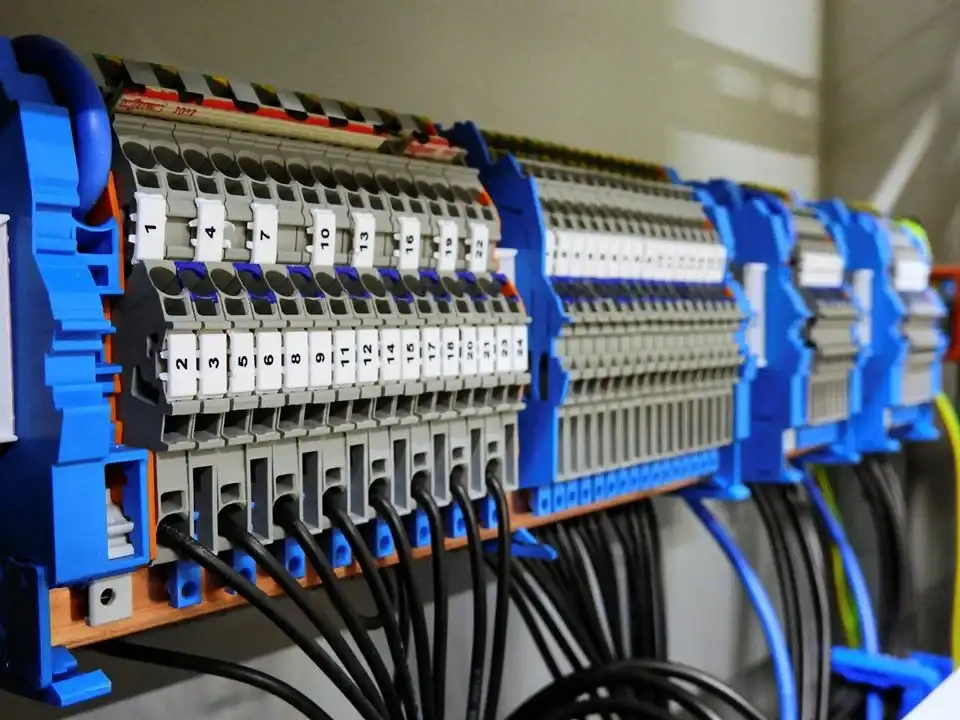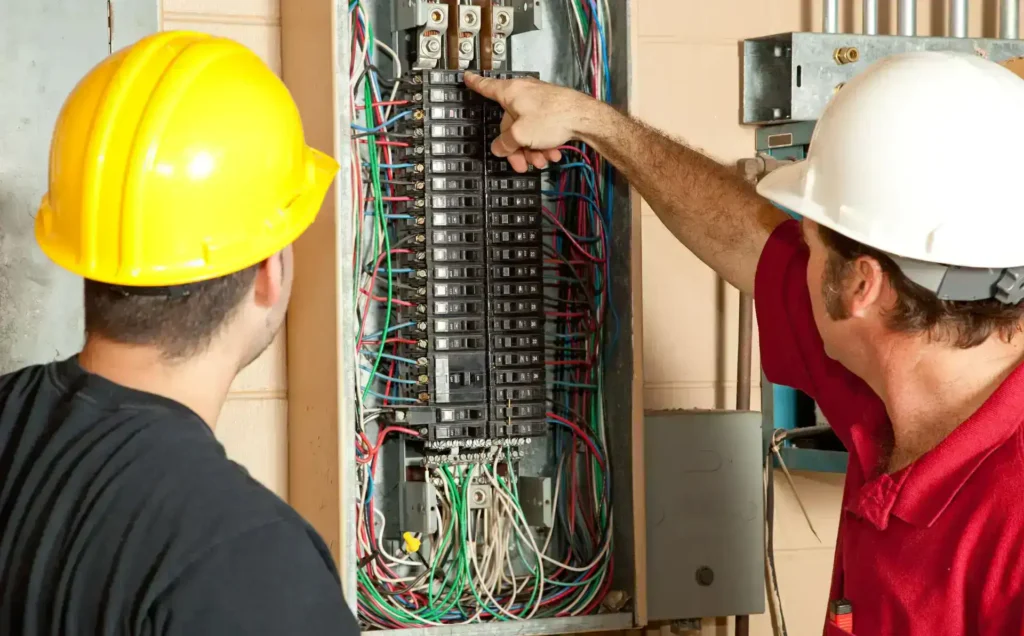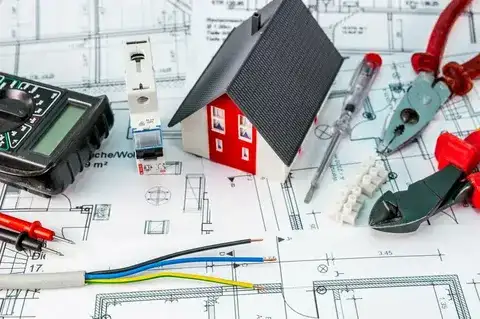New electrical line installations stand as essential undertakings for home and business facilities. A new electrical system or power delivery to unused areas requires this installation method. The expenses needed for a new electrical line are determined by three elements, which include distance requirements, above- or below-ground placement, and local requirements in your community.
The expenses for establishing new electrical lines fall between $5,000 and $25,000. The actual project price depends on two main factors, which are line length measurement and terrain characteristics that the cables need to cross. The following article analyzes the several influential elements that affect the expenses associated with establishing new electrical lines.
Cost to Run a New Electrical Line

The cost to rewire a house varies depending on the area size that should be rewired. Below is a summary of the average price per square foot:
Square feet |
Average cost to rewire |
| 250 sq. ft. | $1,000 – $2,300 |
| 500 sq. ft. | $2,000 – $4,500 |
| 800 sq. ft. | $3,200 – $7,200 |
| 1,000 sq. ft. | $4,000 – $9,000 |
| 1,200 sq. ft. | $4,800 – $10,800 |
| 1,500 sq. ft. | $6,000 – $13,500 |
| 2,000 sq. ft. | $8,000 – $18,000 |
| 2,500 sq. ft. | $10,000 – $22,500 |
| 3,000 sq. ft. | $12,000 – $27,000 |
| 3,500 sq. ft. | $14,000 – $31,500 |
| 4,000 sq. ft. | $16,000 – $36,000 |
New construction electrical cost per square foot
When wiring a new building, electrical expenses typically fall between $4 and $9 per square foot, depending on building size, configuration, and the nature of the circuits needed. The expense may also differ based on design complexity and materials. The following is an estimate of average electrical wiring expenses by room size:
- Kitchen (100 – 200 sq. ft.): $400 – $1,800
- Bedroom (130 – 230 sq. ft.): $520 – $2,100
- Bathroom (40 – 150 sq. ft.): $160 – $1,400
- Living room (200 – 450 sq. ft.): $800 – $4,100
- Basement (500 – 1,500 sq. ft.): $2,000 – $13,500
- Garage (288 – 576 sq. ft.): $1,200 – $5,200
- Shed (50 – 450 sq. ft.): $200 – $4,100
- Shop or metal building (1,200 – 5,000 sq. ft.): $1,500 – $7,800+
You will need to pay between $10 to $25 for each linear foot of underground electric wiring when powering sheds or additional outbuildings. The installation cost depends on three elements, which include the soil composition as well as the distance between the main residence and regional governing laws.
Actual installation costs might fluctuate based on several conditions, including location selection and wiring complexity, together with all required electrical features.
Cost to wire a basement
The total costs for basement wiring span from $2000 to $13500. The price level relies on both the area size and system complexity. Basements with basic designs and smaller dimensions will have a lower cost. The total cost will increase when dealing with larger and more complex basement installations.
The final cost depends on the number of electrical outlets together with the required lighting features and circuit additives. The addition of appliances together with optional characteristics, including home theaters, will drive prices upwards. The completion of a finished basement requires additional expenses because it requires careful planning to reach the desired outcome.
Factors That Affect the Cost of Running a New Electrical Line
Various essential elements determine the total expense of establishing a new electrical line. These determining elements demand further analysis.
1. Distance
How far away your electrical panel sits from your chosen new electrical line location stands as the main point determining costs. The longer distance of installation results in elevated costs for the electricity line. Costs will be lower for a 50-foot shed power supply run than the expense of extending power to a 500-foot building distance. The length of wire that needs installation directly impacts the materials used and worker labor costs.
2. Type of Line (Underground or Above-Ground)
Underground electrical lines are more expensive to install than above-ground lines. This is because underground lines require more work to dig trenches, lay conduit, and bury the wiring. Additionally, underground wiring is often more expensive because it needs to be specially rated for outdoor use. It also requires extra protection to ensure safety and longevity.
Above-ground electrical lines, on the other hand, are typically cheaper. These lines are installed on utility poles or through overhead lines, making the installation process easier and faster. However, above-ground lines can be more vulnerable to weather conditions like storms and high winds, which can cause damage and require repairs.
3. Labour Costs
The expenses for labor will differ based on your location and the difficulty of conducting the installation. Among other factors the standard hourly rate for electricians falls between $50 and $130. The installation process will take several hours to complete when carried out in an easy-to-access location that requires wire running. The labor costs will increase when the wiring installation demands complex preparation together with difficult terrain.
4. Site Conditions
The costs will rise based on the site conditions where electrical line installation takes place. Kelly Electric will provide lower installation prices when land surfaces are easily approachable. Installation costs will increase when sites contain rocky landscapes or slopes or present any other installation obstacles. Construction of underground wiring trenches through rocky ground desiring smooth soil surfaces raises operational expenses by intensifying labor requirements.
5. Permits and Inspections
A permit stands as a necessary requirement for installing new electrical lines in the majority of locations. Permits for electrical projects demand payment in amounts starting from $50 to surpassing $350 or more depending on your specific area and project dimensions. Professionals must conduct inspections of electrical projects because they need to verify that work meets safety standards. The expense of inspections during electrical installation typically spans from $100 to $200 while you might require several inspections to complete the project.
6. Type of Electrical Panel
You must take into account getting a new electrical panel when you set up a fresh electrical service line. The additional electrical load requires a panel replacement because current panels must have sufficient capacity. Electrical panel upgrade expenses fluctuate from $850 up to $2,500 according to the dimensions and installation needs of the project.
Electrical wire pricing for materials
Electrical wire prices range from $0.10 to $4.00 per linear foot, depending on the type of wire. Non-metallic sheathed cable, also known as NM or “Romex,” is commonly used in residential construction and typically costs between $0.50 and $3.00 per linear foot. This wire is ideal for dry, interior spaces like walls and ceilings.
Conduit, which is used to protect electrical wiring in exposed or unfinished areas, is priced between $0.70 and $8.00 per linear foot. The cost of conduit can vary depending on the material and the level of protection it provides for the wire inside.
Coaxial Wire: The cost of coaxial wire ranges from $0.10 to $0.60 per linear foot. The coaxial wire is often used for transmitting signals like cable TV, internet, and video. It consists of a copper conductor, insulation, a metal shielding layer, and an outer protective jacket. It helps reduce interference and maintains signal quality.
Direct Buried Wire: The cost ranges from $0.50 to $3.00 per linear foot. This wire is rated for wet, dry, or damp environments and is designed to be installed underground without the need for conduit. It is typically used for underground power lines and service entrance cables.
Metallic Sheathed AC/BX Wire: The cost range is $0.60 to $4.00 per linear foot. This wire features an armored aluminum sheath, protecting against physical damage. It is commonly used in exposed interior installations like basements and garages.
Multiple-Conductor Wire: The cost range is $0.20 to $1.00 per linear foot. A multiple-conductor wire contains two or more individually insulated conductors. It is used in applications like security systems, audio/video setups, and fire protection signaling systems.
Non-Metallic Sheathed (NM) Wire: The cost range is $0.50 to $3.00 per linear foot. Also known as Romex, NM wire is used for residential wiring in dry locations. It includes multiple insulated conductors inside a flexible plastic sheath, making it easy to install in walls and ceilings.
Ribbon Wire: The cost range is $0.80 to $1.80 per linear foot. Ribbon wire is a flat, flexible cable that is often used in low-voltage applications like LED strip lighting and sound equipment. Its flat design makes it easy to conceal in tight spaces.
Shielded Twisted Pair (STP) Wire: The cost range is $0.20 to $0.40 per linear foot. STP wire consists of pairs of twisted wires surrounded by a shield, which protects against electromagnetic and radio frequency interference. It is commonly used in networking and data communications.
Twin-Lead Wire: The cost range is $0.60 to $0.90 per linear foot. Twin-lead wire is a flat, ribbon-style cable used for transmitting radio frequency signals. It is mainly used to connect antennas to radio receivers or transmitters.
Underground Feeder Wire: The cost range is $0.50–$1.30 per linear foot. This type of wire is used for supplying power to outdoor structures such as garages, lighting fixtures, and pumps. It is designed for both indoor and outdoor use, providing a reliable electrical connection in tough environments.
Conclusion
Various factors affect the cost of putting in a new electrical line. Distance, type of line, labor cost, and site conditions all contribute to costs that can start around $10 and go up to $25 per foot for an underground line, while overhead costs are typically $2 to $10 per foot. Permitting, inspections, upgrading electrical panels, or any of several other things will, of course, add other charges. Planning and comparing quotes from different electricians can save costs on the project as well.
FAQs
Q1. How much does it cost to run a dedicated electrical line?
The expense to install a dedicated electrical line is usually between $250 and $900. This varies according to distance, complexity, and the nature of the circuit to be installed.
Q2. How much does an electrical line cost?
The expense of installing an electrical line ranges from $2,500 to $12,500 for 500 feet, with underground lines costing more than above-ground lines.
Q3. How much does it cost to install an electrical line?
To install an electrical line, the price typically ranges from $1,500 to $3,000, depending on the complexity of the job and the distance.
Q4. How much wire for a 1000 sq ft home?
A 1,000 sq ft home usually needs 500 to 1,000 feet of electrical wire, depending on the design, number of circuits, and whether or not the house has a basement or attic.
Q4. How to estimate wiring cost?
To determine wiring cost, multiply the total square footage by the price per square foot. Consider factors like labor, materials, and the type of wiring needed for various areas.


